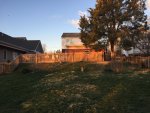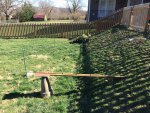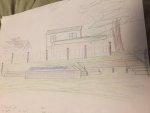- Joined
- Mar 27, 2017
- Messages
- 18
- Reaction score
- 18
- Location
- Shenandoah Valley, Virginia
- Hardiness Zone
- 6b
- Country

Help! analysis paralysis! I miss my old pond so much, I’m ready to build a bigger, better pond at our new house in town. Exactly how to do that has been driving me crazy. So thought I’d join your forum and drive ya’ll crazy too. I am aiming for:
- 12’ x 5’ retaining wall, about 20” high. Deep end about 36” so dig out. Shallow end about 16”so fill in. Net capacity 700 – 800 gallons.
- mostly goldfish and waterlilies. Eventually a koi or 2, but not trying for show quality or huge specimens.
- regular black epdm liner, underlayment; waterfall filter, submersible pump.
- our dogs will have access to the pond. Will train them to stay out of the deep end, but will let them romp in the shallow end. That can be another thread.
- zone 6b – cold snaps in the single digits, hot spells around 100F.
- soil is mix of clay and loam, and chock full of shale-y rock.
- area gets full sun until mid-afternoon.
- Pictures: our lot is 50’ wide. The gentleman who built the house 75 years ago constructed an even slope across the whole 50’, keeping the house and garage on a level about 5 or 6 foot higher than the back yard. There is a brick wall and steps on both sides, but we usually scramble down the middle. Sketch shows pond sited near base of current slope, with a retaining wall on one side and a viewing deck on the other. I’ll ‘gentle’ the slope, extending it down to wrap around the back of the pond, planting it with native grasses and flowers. I’ll allow for drainage above and below, keeping run-off out of the pond.
Crazy question #1 – what to make the rectangle out of. We’re narrowing in on Eagle Bay “Highland Stone Free Standing Wall block”, 9” wide, with a 13” bullnose capstone. It doesn’t have the lip on the back like a retaining wall block. It doesn’t have holes for concrete and rebar like cinderblock does.
- will the blocks be strong enough just glued together? (I thought about dry stack concrete block, but then I'd have to make the outside look pretty. I'd rather use wall block that is attractive from the start. Took weeks to reach that conclusion...!)
- right angles can be weak, straight sides can be problems when ponds ice over. Should I use clay/mud or ? to smooth out the backside of the block wall, and round out the corners?
- I’ve read and like the idea of using rigid pink foamboard on the sides for a little extra insulation. Whatever mix I use for smoothing out the corners, could I use a little more and end up with the foamboard at a slight outward angle, instead of absolutely straight up and down?
- would any of that add to the strength of the wall, or make it worse?
- one full wall of the pond rectangle will be buried in the slope, never to be seen. Do I buy enough fancy block to build it same as other 3 sides, or can I use cinder block for the 4th wall? It’s not the same dimension so I can’t picture how to weave it in.
More crazy questions to follow, after this one digests a while. Thanks in advance!


- 12’ x 5’ retaining wall, about 20” high. Deep end about 36” so dig out. Shallow end about 16”so fill in. Net capacity 700 – 800 gallons.
- mostly goldfish and waterlilies. Eventually a koi or 2, but not trying for show quality or huge specimens.
- regular black epdm liner, underlayment; waterfall filter, submersible pump.
- our dogs will have access to the pond. Will train them to stay out of the deep end, but will let them romp in the shallow end. That can be another thread.
- zone 6b – cold snaps in the single digits, hot spells around 100F.
- soil is mix of clay and loam, and chock full of shale-y rock.
- area gets full sun until mid-afternoon.
- Pictures: our lot is 50’ wide. The gentleman who built the house 75 years ago constructed an even slope across the whole 50’, keeping the house and garage on a level about 5 or 6 foot higher than the back yard. There is a brick wall and steps on both sides, but we usually scramble down the middle. Sketch shows pond sited near base of current slope, with a retaining wall on one side and a viewing deck on the other. I’ll ‘gentle’ the slope, extending it down to wrap around the back of the pond, planting it with native grasses and flowers. I’ll allow for drainage above and below, keeping run-off out of the pond.
Crazy question #1 – what to make the rectangle out of. We’re narrowing in on Eagle Bay “Highland Stone Free Standing Wall block”, 9” wide, with a 13” bullnose capstone. It doesn’t have the lip on the back like a retaining wall block. It doesn’t have holes for concrete and rebar like cinderblock does.
- will the blocks be strong enough just glued together? (I thought about dry stack concrete block, but then I'd have to make the outside look pretty. I'd rather use wall block that is attractive from the start. Took weeks to reach that conclusion...!)
- right angles can be weak, straight sides can be problems when ponds ice over. Should I use clay/mud or ? to smooth out the backside of the block wall, and round out the corners?
- I’ve read and like the idea of using rigid pink foamboard on the sides for a little extra insulation. Whatever mix I use for smoothing out the corners, could I use a little more and end up with the foamboard at a slight outward angle, instead of absolutely straight up and down?
- would any of that add to the strength of the wall, or make it worse?
- one full wall of the pond rectangle will be buried in the slope, never to be seen. Do I buy enough fancy block to build it same as other 3 sides, or can I use cinder block for the 4th wall? It’s not the same dimension so I can’t picture how to weave it in.
More crazy questions to follow, after this one digests a while. Thanks in advance!










